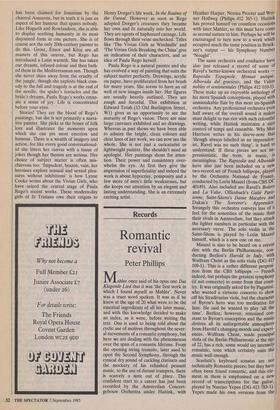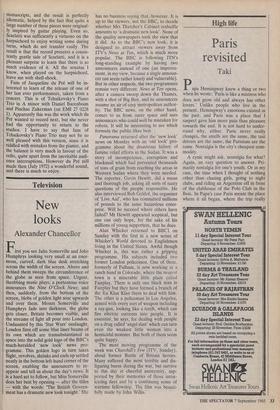Records
Romantic revival
Peter Phillips
Mahler once said of his opus one Das Klagende Lied that it was 'the first work in which I found myself as Mahler'. Never was a truer word spoken. It was as if he knew at the age of 20 what were to be the essential ingredients of all his later music, and with this knowledge decided to make an index, as it were, before writing the text. One is used to being told about the cyclic use of motives throughout the sever- al movements of a romantic symphony, but here we are dealing with the phenomenon over the span of a romantic lifetime. From the opening string tremolo, later used to open the Second Symphony, through the cynical dry sound of cackling clarinets and the mockery of his rehashed peasant music, to the use of distant trumpets, there is scarcely a note out of place. This confident start to a career has just been recorded by the Amsterdam Concert- gebouw Orchestra under Haitink, with Heather Harper, Norma Procter and Wer- ner Hollweg (Philips 412 365-1). Haitink has proved himself on countless occasions with later Mahler, so this must have come as second nature to him. Perhaps he will be encouraged to turn now to a work which occupied much the same position in Bruck ner's output — his Symphony Number `Nought'. The same orchestra and conductor have also just released a record of some of Ravel's better-known orchestral works Rapsodie Espagnole, Menuet antique, Alborada del gracioso, and the Valses nobles et sentimentales (Philips 412 010-1). These make up an enjoyable anthology of his more Spanish conceptions, played with unmistakable flair by this most un-Spanish orchestra. Any professional orchestra even half aware of the overall sound it makes must delight to run riot with such colourful writing, while Haitink maintains a sure control of tempi and ensemble. Why Max Harrison writes in his sleeve-note that `though always labelled as an impression- ist, Ravel was no such thing', is hard to understand. If these pieces are not im- pressionistic, the term, in music, is meaningless. The Rapsodie and Alborada have also just been included on a new two-record set of French lollipops, played by the Orchestre National de France, conducted by Lorin Maazel (from CBS DC 40149). Also included are Ravel's Bolero and La Valse, Offenbach's Gaite Paris- ienne, Saint-Sdens's Danse Macabre and Dukas's The Sorcerer's Apprentice. Strangely this orchestra conveys less of a feel for the sonorities of the music than their rivals in Amsterdam, but they attack the lighter numbers in particular with the necessary verve. The solo violin in the Saint-Sdens is played by Lorin Maazel himself, which is a new one on me.
Maazel is also to be heard on a recent disc with the Berlin Philharmonic, con- ducting Berlioz's Harold in Italy, with Wolfram Christ as the solo viola (DG 415 109-1). This is a rather different proposi- tion from the CBS lollipops — French indeed, but perhaps the greatest symphony (if not concerto) to come from that coun- try. It was originally asked for by Paganini, who wanted a virtuoso concerto to show :off his Stradivarius viola, but the character of Byron's hero was too meditative for him. He said he wanted to play 'all the time'. Berlioz, however, remained con- stant to Byron's conception and the music derives all its unforgettable atmosphere from Harold's changing moods and experi- ences. Wolfram Christ, made principal viola of the Berlin Philharmonic at the age of 22, has a rich, some would say intensely romantic, tone which certainly suits the music well enough. Scarlatti's keyboard sonatas are not technically Romantic pieces; but they have often been found romantic, and this ele- ment in them is emphasised on a new record of transcriptions for the guitar, played by Narciso Yepes (DG 413 783-1). Yepes made his own versions from the manuscripts, and the result is perfectly idiomatic, helped by the fact that quite a large number of these pieces were original- ly inspired by guitar playing. Even so, Scarlatti was sufficiently a virtuoso on the harpsichord to enjoy writing some daring turns, which do not transfer easily. The result is that the record presents a consis- tently gentle side of Scarlatti, and it is a pleasant surprise to learn that there is so much evidence of it. All the sonatas I know, when played on the harpsichord, leave me with shell-shock.
Fans of Jacqueline du Pre will be in- terested to learn of the release of one of her last ever performances, taken from a concert. This is of Tchaikovsky's Piano Trio in A minor with Daniel Barenboim and Pinchas Zukerman (on EMI 27 0228 1). Apparently this was the work which du Pre wanted to record next, but she never had the opportunity to return to the studios. I have to say that fans of Tchaikovsky's Piano Trio may not be so well pleased with this version, since it is riddled with mistakes from the pianist, and the balance is very much in favour of the cello, quite apart from the inevitable audi- ence interruptions. However du Pre" still made then (July 1972) a wonderful sound, and there is much to enjoy.











































 Previous page
Previous page